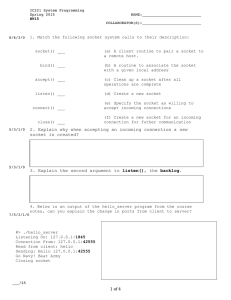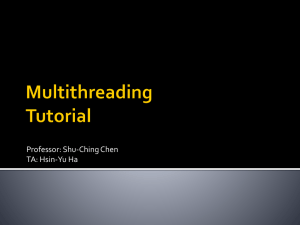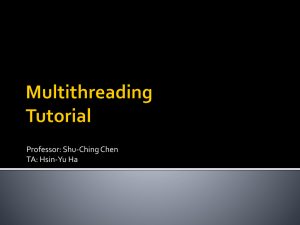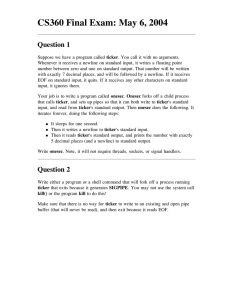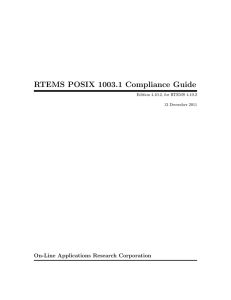Document 11229216
advertisement
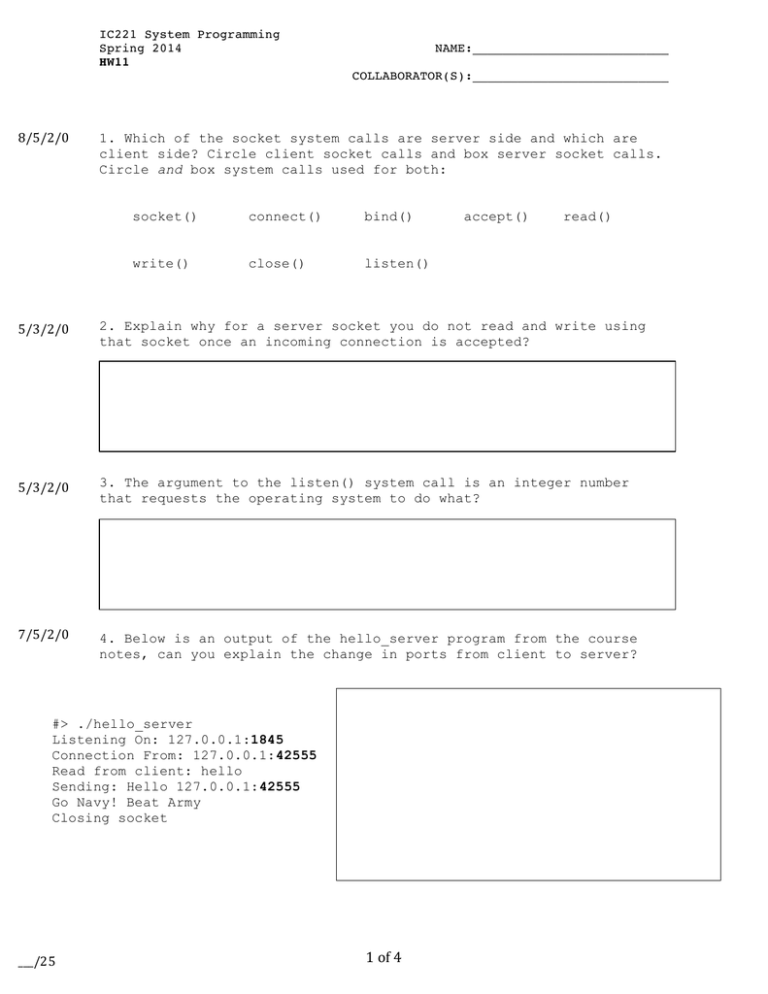
IC221 System Programming
Spring 2014
HW11
NAME:__________________________
COLLABORATOR(S):__________________________ 8/5/2/0 5/3/2/0 1. Which of the socket system calls are server side and which are
client side? Circle client socket calls and box server socket calls.
Circle and box system calls used for both:
socket()
connect()
bind()
write()
close()
listen()
accept()
read()
2. Explain why for a server socket you do not read and write using
that socket once an incoming connection is accepted?
5/3/2/0 3. The argument to the listen() system call is an integer number
that requests the operating system to do what?
7/5/2/0 4. Below is an output of the hello_server program from the course
notes, can you explain the change in ports from client to server?
#> ./hello_server
Listening On: 127.0.0.1:1845
Connection From: 127.0.0.1:42555
Read from client: hello
Sending: Hello 127.0.0.1:42555
Go Navy! Beat Army
Closing socket
___/25 1 of 4 NAME:
NAME: __________________________
__________________________ 10/8/5/2/0 5. Consider the code loop for handling client sockets: Can this
program handle multiple clients simultaneously? That is, if multiple
clients are connected, will the server be able to services all
sockets when data is available? Explain.
char buf[BUF_SIZE];
int sockets[NUMSOCKS], i,n;
//iterate over all open sockets
for(i=0;i < NUMSOCKS; i++){
if(i>0){
//read from socket
n = read(sockets[i], buf, BUF_SIZE);
//socket closed
if(n<0){
close(sockets[i]);
sockets[i] = -1;
}
//echo back
write(sockets[i], buf, n);
}
}
7/5/2/0 6. What is the select() system call used for and how does it relate
to blocking on read/write/accept for sockets and socket-servers?
8/5/2/0 7. Match the programing unit to its description.
FD_ZERO() ____
(a) Check if a file descriptor in the fd_set
is actionable, e.g., can be read/write from.
select() ____
(b) Type for storing select information for a
set of file descriptors
fd_set ____
FD_ISSET() ____
___/25 (c) Set a file descriptor to be tested as
actionable by select()
(d) Given a set of file descriptors, test if
any are actionable
FD_SET() ____
(e) Remove a file descriptor from the testing
set
FD_CLR() ____
(f) Completely clear the set of file
descriptors
2 of 4 NAME:
NAME: __________________________
__________________________ 8. For each of the statements, indicate if the statement is True or
False. You must provide an additional brief statement in support of
your selection:
(a)
5/3/2/0 Threads are created just like processes by calling fork()
except instead of checking the return value of fork() a
specified function is executed.
TRUE / FALSE
(b)
Threads are scheduled just like other processes because POSIX
threads are treated like individual process by the OS.
TRUE / FALSE
5/3/2/0 (c)
Like multiple processes, threads provide resource isolation.
Two threads from the same program do not share memory or other
resources.
TRUE / FALSE
5/3/2/0 9. Fill in the following program that prints the first command line
argument from the thread. For each line of code you add, provide a
brief comment describing the purpose/function:
10/8/5/2/0 void * startup( void * args){
char * str; //varible to reference string to print
printf(
return NULL;
);
}
int main(int argc, char * argv[]){
pthread_t thread; //POSIX thread identifier
//create a thread to run startup with argument argv[1]
pthread_create(&thread, NULL, startup, argv[1]);
return 0;
___/25 }
3 of 4 NAME:
NAME: __________________________
__________________________ 10. Answer the following questions about the program to the left,
assume the program was run on the lab machines:
(a) Based on the code, what are the two
possible values for the argument to foo()?
#include <stdio.h>
#include <stdlib.h>
#include <pthread.h>
5/3/2/0 void * foo(void * args){
pthread_t thread;
if(args == NULL){
pthread_create(&thread, NULL,
foo, (void *) 1);
}
(b) When you run this program, how many
threads are running. Use ps –L to count:
while(1);
5/3/2/0 }
int main(int argc, char * argv[]){
pthread_t threads[4];
int i;
for(i=0;i<4;i++){
pthread_create(&threads[i], NULL,
foo, NULL);
}
(c) According to top what percent CPU does
the program consume? Is this more or less
than you expect? Explain.
5/3/2/0 while(1);
}
11. Match the identifier to its description:
10/8/5/2/0 tid ____
(a)
Retrieve the POSIX thread identifier
for the calling thread
pid ____
(b)
The process identifier, shared by all
threads of a multi-threaded program
pid_t ____
(c)
Retrieve the Unix OS thread
identifier of the calling thread
pthread_t ____
(d)
Retrieve the Unix OS process
identifier of the calling process
syscall (SYS_gettid); ____
(e)
The type of a POSIX thread identifier
(f)
The type of the Unix OS thread
identifier
(g)
The thread identifier, unique to each
thread and equal to the pid for the
main thread
getpid() ____
pthread_self() ____
___/25 4 of 4
